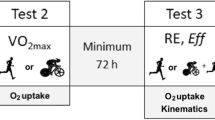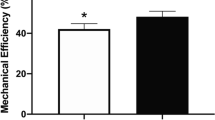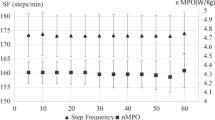Abstract
The purpose of the present study was to verify the increase in energy cost of running at the end of a triathlon. A group 11 trained male subjects performed a triathlon (15-km swimming, 40-km cycling, 10-km running). At least 1 week later the subjects ran 10-km as a control at the same pace as the triathlon. Oxygen uptake (\(\dot V\)O2), ventilation (\(\dot V\) E) and heart rate (HR) were measured during both 10-km runs with a portable telemetry system. Blood samples were taken prior to the start of the triathlon and control run, after swimming, cycling, triathlon run and control run. Compared to the control values the results demonstrated that triathlon running elicited a significantly higher (P < 0.005) mean \(\dot V\)O2 [51.2 (SEM 0.4) vs 47.8 (SEM 0.4) ml·min−1·kg−] \(\dot V\) E [86 (SEM 4.2) vs 74 (SEM 5.3) l·min−1], and HR [162 (SEM 2) vs 156 (SEM 1.9) beats·min−1)]. The triathlon run induced a greater loss in body mass than the control run [2 (SEM 0.2) vs 0.6 (SEM 0.2) kg], and a greater decrease in plasma volume [14.4% (SEM 1.5) vs 6.7% (SEM 0.9)]. The lactate concentrations observed at the end of both 10-km runs did not differ [2.9 (SEM 0.2) vs 2.5 (SEM 0.2) m·mol·l−1]. Plasma free fatty acids concentrations were higher (P < 0.01) after the triathlon than after the control run [1.53 (SEM 0.2) to 0.51 (SEM 0.07) mmol·l−1]. Plasma creatine kinase concentrations rose under both conditions from 58 (SEM 12) to 112 (SEM 14) UI·l−1 after the triathlon, and from 61 (SEM 7) to 80 (SEM 6) UI·l−1 after the control run. This outdoor study of running economy at the end of an Olympic distance triathlon demonstrated a decrease in running efficiency.
Similar content being viewed by others
References
Armstrong RB, Marum P, Saubert CW, Seeherman HJ, Taylor RC (1977) Muscle fiber activity as a function of speed and gait. J Appl Physiol 43:672–677
Armstrong RB, Delp MD, Goljan EF, Laughlin MH (1987) Distribution of blood flow in muscle of miniature swine during exercise. J Appl Physiol 62:1285–1298
Bahr R, Opstad PK, Medbo JI, Sejersted OM (1991) Strenuous prolonged exercise elevates testing metabolic rate and causes reduced mechanical efficiency. Acta Physiol Scand 141:555–563
Bigard AX, Guezennec CY (1995) Evaluation of the cosmed K2 telemetry system during exercise at moderate altitude. Med Sci Sports Exerc 27:1333–1338
Boone T, Kreider RB (1986) Bicycle exercise before running:effect on performance. Ann Sports Med 3:25–26
Bosch AN, Goslin BR, Noakes TD, Dennis SC (1990) Physiological differences between black and white runners during a treadmill marathon. Eur J Appl Physiol 61:68–72
Brueckner JC, Atchou G, Capelli C, Duvallet A, Barrault D, Jousselin E, Rieu M, Dl Prampero PE (1991) The energy cost of running increases with the distance covered. Eur J Appl Physiol 62:385–389
Bulow L (1988) Lipid mobilization and utilization. Principles of exercise bio-chemistry Med Sport Sci 27:140–163
Carlson LA (1967) Lipid metabolism and muscular work. Fed Proc Fed Am Soc Exp Biol 26:1755–1759
Casaburi R, Storer TW, Bendov I, Wasserman J (1987) Effect of endurance training on possible determinants of VO2 during heavy exercise. J Appl Physiol 62:199–207
Coast JR, Krause KM (1993) Relationship of oxygen consumption and cardiac outpout to work of breathing. Med Sci Sports Exerc 25:335–340
Costill D, Winrow E (1970) A comparison of two middle-aged ultra marathon runners. Res Q 41:135–139
Dal Monte A, Faina M, Leonard LM, Todara A, Guidi G, Petrelli G (1989) Maximum oxygen consumption by telemetry. Scuola Dello Sport. CONI (Anno VIII), 15:35–44
Daniels J, Oldridge N, Nagle F, White B (1978) Differences and changes in VO2 among young runners 10 to 18 years of age. Med Sci Sports Exerc 10:200–203
Dick RW, Cavanaugh PR (1987) An explanation of the upward drift in oxygen uptake during prolonged sub-maximal downwhill running. Med Sci Sports Exerc 19:310–317
Guezennec CY, Defer G, Cazorla G, Sabathier C, Lhoste F (1986a) Plasma renin activity, aldosterone and catecholamine levels when swimming and running. Eur J Appl Physiol 54:632–637
Guezennec CY, Giaoui M, Voignier JP, Legrand H, Fournier E (1986b) Evolution of plasma levels of LDH, CPK and myoglobin at the end of a 100 km race and a triathlon. Sci Sports 1:255–263
Hagberg JM, Mullin JP, Nagle FJ (1978) Oxygen consumption during constant load exercise. J Appl Physiol 45:381–384
Hanson P, Claremont A, Dempsey J, Reddan W (1982) Determinants and consequences of ventilatory responses to competitive endurance running. J Appl Physiol 52:615–623
Iwane H (1987) A follow-up study of changes in serum myoglobin and enzyme levels in Japanese triathletes. Ann Sports Med 3:139–143
Kawakami Y, Nozaki D, Matsuo A, Fukunaga T (1992) Reliability of measurement of oxygen uptake by a portable telemetric system. Eur J Appl Physiol 65:409–414
Kram R, Taylor CR (1990) Energetics of running a new perspective. Nature 346:265–266
Kreider RB, Boone T, Thompson WR, Burkes S, Cortes CW (1988) Cardiovascular and thermal response of triathlon performance. Med Sci Sports Exerc 20:385–390
Long D, Blake M, McNaughton L, Angle B (1990) Haematological changes during a short triathlon competition in novice triathletes. Eur J Appl Physiol 61:93–99
Lucia A, Fleck SJ, Gotshall RW, Kearney JT (1993) Validity and reliability of the cosmed K2 instrument. Int J Sports Med 14:380–386
McNaughton LM (1989) Plasma volume responses associated with a sprint triathlon in novice triathletes. Int J Sports Med 3:161–164
Morgan DW, Martin PE, Krahenbuhl GS (1989) Factors affecting running economy. Sports Med 7:310–330
O'Toole ML, Douglas PS, Lueler WDB (1989) Lactate, oxygen uptake and cycling performance in triathletes. Int J Sports Med 10:413–418
Peel C, Utsey U (1993). Oxygen consumption using the K2 telemetry system and a metabolic cent. Med Sci Sports Exerc 25:296–400
Poole DC, Schaffartzik W, Knight DR, Derion D, Kennedy B, Guy HJ, Predileto R, Wagner PD (1991) Contribution of exercising leg to the slow component of oxygen uptake kinetic in humans. J Appl Physiol 71:1245–1253
Pugh L (1971) The effect of wind resistance in running and walking and the mechanical efficiency of work against horizontal and vertical forces J Physiol 213:255–270
Sejersted OM, Vollestad N (1992) Increased metabolic rate associated with muscle fatigue. Muscle fatigue mechanisms in exercise and training. Med Sports Sci 34:115–130
Shephard RJ (1966) The oxygen cost of breathing during vigorous exercise. QJ Exp Physiol 51:336–350
Van Beaumont W (1973) Red cell volume changes in plasma osmolarity during maximal exercise. J Appl Physiol 35:47–50
Van Rensburg JP, Kielbock AJ, Vanderlinde A (1986) Physiologic and biochemical changes during a triathlon competition. Int J Sports Med 7:30–35
Whipp J, Wasserman K (1972) Oxygen uptake kinetics for various intensities of constant-load work. J Appl Physiol 33:351–356
Author information
Authors and Affiliations
Rights and permissions
About this article
Cite this article
Guezennec, C.Y., Vallier, J.M., Bigard, A.X. et al. Increase in energy cost of running at the end of a triathlon. Europ J Appl Physiol 73, 440–445 (1996). https://doi.org/10.1007/BF00334421
Accepted:
Issue Date:
DOI: https://doi.org/10.1007/BF00334421




